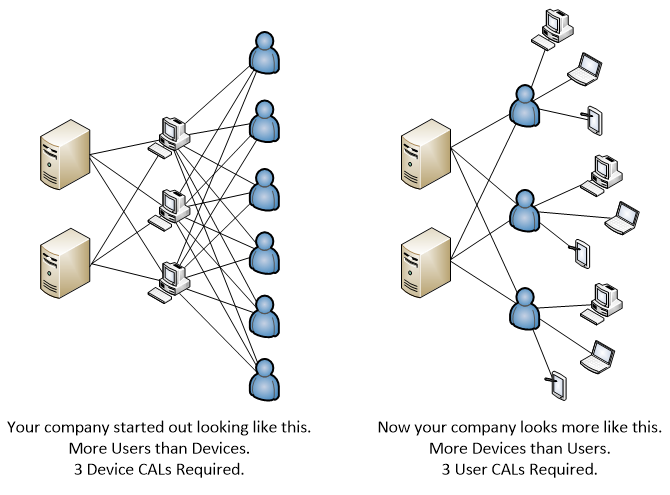Switching between Device and User CALs
By: Lacey Hartje
Summary: With the consumerization of IT, and the proliferation of devices in the workplace, it is now as important as ever that the licensing model you use is delivering the most value to your business. Our volume licensing programs can offer the flexibility and improved manageability to ensure your CAL licensing model is optimally matched with your organization’s needs. If your business needs change and you want to switch from your current method of Client Access Licensing (CAL) there is an opportunity to switch from Device to User CALs or vice versa. That opportunity comes when you renew Software Assurance (SA) on your CALs.
Let’s say your Company chose license access to server software with Device Client Access Licenses (CALs) in the early days of the business because Device CALs made economic sense as you had more employees than devices. By licensing devices, you were guaranteed that all access to the server software was properly licensed and this was the most cost effective solution.
Now let’s fast-forward a few years. Your devices outnumber your employees. Put another way, each employee now has multiple devices; a PC, a laptop, a tablet, or a smart phone and you want them to be able to access your server software with ALL of these devices. The most cost effective licensing solution for this scenario is to license client access by User CALs.
If this mix between users and devices exists in your organization it’s a likely indication that you should consider switching from Device CALs to User CALs as it is more cost effective and applicable for your business needs.
How is this accomplished? Here are the key steps you’ll need to take:
- First, confirm that your CALs are covered by active Software Assurance (SA).
- Second, the switch is made ONLY at the time of SA renewal on the CALs. This licensing situation is outlined in the Product List. If you’re searching the Product List for this text, it’s called transitioning between User and Device CALs.
Client Access License (CAL) Decision Tool
In closing, volume licensing and active software assurance can give you the flexibility to switch between User and Device based CALs upon renewal of your SA coverage. Refer to the current Product List, contact our Pre-Sales/Licensing customer service team, or work with your reseller or account team if you have additional questions.
This is one scenario, and licensing situation. Each customer scenario can vary by deployment, usage, product version, and product use rights. Always check your contract, and the current Products Use Rights document to confirm how your environment should be fully licensed. The blogging team does not warrant that this scenario will be the right licensing solution for other similar cases.
Comments
Anonymous
April 11, 2013
so is this also applicable for TS CAL, RDS CAL?Anonymous
April 11, 2013
@Khalid - yes, it applies to any type of CAL, including RDS/TS CALsAnonymous
July 24, 2013
Hey there! Thanks for the information! What about mixing user and devices CALs? I have an amount of device CALs without software assurance and need to get more CALs. The user CAL model now fits better in my company than it did some years ago. How can I use and calculate the mix of both CALs? Thanks!Anonymous
July 24, 2013
@ Daniel Will. While not explicitly outlined anyplace in our licensing materials (e.g. the license terms, or Product Use Rights), it is possible to use a mix of device and user CALs. Its not typically suggested, but if you are able to effectively manage a combination of device and user CALs - than there is nothing wrong with doing so. A common example we get is generally Exchange Server. Lets say you have 100 device CALs for Exchange today. Your users are now wanting to bring in their own mobile devices and use them to check email, manage calendars, contacts, etc. There are two ways to handle this. Buying additional device CALs to cover each mobile device, or buying User CALs to cover the users. Something else you must consider (in this example at least) - you'll need to also buy CALs for the underlying OS as well. This being said, you would simply buy Exchange and Windows Server user CALs for each user that you want to cover under the user model. Like I mention above, it will be important at this point that you document someplace which users are covered with user CALs (and which devices covered with device CALs) - but as long as you can do so effectively, there are no other issues with combining CAL types. I hope this helps!Anonymous
January 29, 2014
Hi, how about in OVS agreement, is it possible to mix Core CALs (device and user)? For eg. 100 workstation and 50pcs. CoreCALUsrCAL and 50pcs. CoreCALDvcCAL.Anonymous
July 04, 2014
Hi, is it possible to mix Core CALs (device and user)? For eg. 100 workstation and 50pcs. CoreCALUsrCAL and 50pcs. CoreCALDvcCAL.Anonymous
March 10, 2016
How about the difference from User CALs / Device CALs / RDS CALs ?
RDS CALs isn't apporpriate for RDP access to servers ?
